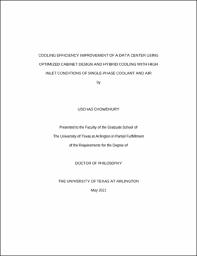
ATTENTION: The works hosted here are being migrated to a new repository that will consolidate resources, improve discoverability, and better show UTA's research impact on the global community. We will update authors as the migration progresses. Please see MavMatrix for more information.
Show simple item record
| dc.contributor.advisor | Agonafer, Dereje | |
| dc.creator | Chowdhury, Uschas | |
| dc.date.accessioned | 2021-06-01T17:32:58Z | |
| dc.date.available | 2021-06-01T17:32:58Z | |
| dc.date.created | 2021-05 | |
| dc.date.issued | 2021-05-15 | |
| dc.date.submitted | May 2021 | |
| dc.identifier.uri | http://hdl.handle.net/10106/29777 | |
| dc.description.abstract | The objective of this study is to improve and optimize the cooling efficiency of liquid and air cooling from server to room level while applying best practices in the industry. The effect of increased air and coolant temperature has been explored through a literature survey and studies are conducted from device level to room level for air and liquid cooling. Three major aspects are considered. A closed-form air cooling solution is proposed for high-powered racks in a modular data center equipped with in-row coolers. Direct-to-chip liquid cooling technology is extensively studied at the server level for raised air and coolant inlet temperature for determining thermal performance and reliability of IT equipment. A cost analysis for liquid cooling has been conducted with a TCO model for the performance improvement and holistic evaluation of a data center with air and liquid cooling.
The first part consists of a room-level numerical study conducted with high-powered racks in a modular data center with regular low-powered racks. Typical modular data centers are cooled by perimeter or outdoor cooling units. A comparative analysis is performed for a typical small-sized non-raised facility to investigate the efficacy and limitations of in-row coolers in thermal management of IT equipment with variation in rack heat load and containment. Several other aspects like a parametric study of variable opening areas of duct between racks and in-row coolers, the variation of operating flow rate, and failure scenarios are also studied to find proper flow distribution, uniformity of outlet temperature, and predict better performance, energy savings and reliability. The results are presented for general guidance for flexible and quick installation and safe operation of in-row coolers to improve thermal efficiency.
The Second Part consists of a server-level numerical and experimental study with raised inlet air and coolant temperature for a hybrid cooled server. A detailed numerical study of an enterprise 1U hybrid cooled server is performed to predict the effect of raised inlet air temperature on the component temperatures following the limits of ASHARE air cooling classes. Then, an experimental study is performed in an environmental chamber with high inlet air temperatures. Results for both studies are compared. Previously warm water cooling or increased coolant inlet temperature has been experimentally tested on the respective server. Thus, the effect of both air and liquid coolant temperature has been presented and scaled up to a data center level with help of industry-standard tools for 1D flow network analysis to address the cooling efficiency improvement.
The third part consists of a cost analysis of a data center with air and liquid cooling using an established TCO model. The ASHRAE cooling classes for air and liquid cooling are used based on the experimental findings. Also, the effect of cooling efficiency improvements at component and server level and increased inlet conditions are used to compare with a baseline model with air cooling. | |
| dc.format.mimetype | application/pdf | |
| dc.language.iso | en_US | |
| dc.subject | Data center | |
| dc.subject | Liquid cooling | |
| dc.subject | Air cooling | |
| dc.subject | Hybrid cooling | |
| dc.subject | TCO | |
| dc.title | COOLING EFFICIENCY IMPROVEMENT OF A DATA CENTER USING OPTIMIZED CABINET DESIGN AND HYBRID COOLING WITH HIGH INLET CONDITIONS OF SINGLE-PHASE COOLANT AND AIR | |
| dc.type | Thesis | |
| dc.degree.department | Mechanical and Aerospace Engineering | |
| dc.degree.name | Doctor of Philosophy in Mechanical Engineering | |
| dc.date.updated | 2021-06-01T17:32:59Z | |
| thesis.degree.department | Mechanical and Aerospace Engineering | |
| thesis.degree.grantor | The University of Texas at Arlington | |
| thesis.degree.level | Doctoral | |
| thesis.degree.name | Doctor of Philosophy in Mechanical Engineering | |
| dc.type.material | text | |
Files in this item
- Name:
- CHOWDHURY-DISSERTATION-2021.pdf
- Size:
- 3.764Mb
- Format:
- PDF
This item appears in the following Collection(s)
Show simple item record


